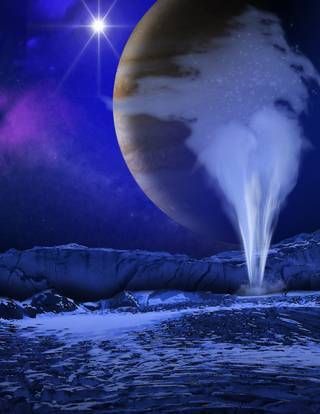Alfred McEwen’s HiRISE camera has brought the dynamic features of Mars into sharp focus over the past nine years. Now he plans to give Jupiter’s moon Europa its first closeup.
McEwen, of the University of Arizona’s Lunar and Planetary Lab, is deputy investigator for the Europa Imaging System — two cameras selected by NASA on Tuesday for an upcoming mission to the frozen, fractured moon.
McEwen’s cameras will be built at the Applied Physics Lab at Johns Hopkins University, home of the team’s principal investigator, Elizabeth Turtle, formerly of UA.
McEwen and Turtle have also teamed up to propose a NASA Discovery mission to another Jovian moon, Io. The selection in that competition will be announced in the fall.
Europa’s icy shell is thought to harbor a vast ocean that occasionally reaches the surface through cracks caused by tidal forces and undersea hydrothermal vents. Those areas, where heat, light and chemistry combine, might be the best place to look for life in our solar system, NASA scientists say.
McEwen is one of seven Arizona planetary scientists with roles on the instrument teams for the upcoming $2 billion mission.
Amy Barr Mlinar and Candice Hansen, both with Tucson-based Planetary Science Institute, are co-investigators on Turtle and McEwen’s camera team.
Mlinar is also a co-investigator on a radar instrument that will probe and characterize the structure of the moon’s icy crust.
Roger Clark of PSI is a co-investigator on the Mapping Image Spectrometer for Europa (MISE), according to a statement from PSI spokesman Alan Fischer.
One of the Europa-bound instruments, a thermal emission detector, will be built by a team headed by Phil Christensen at Arizona State University’s School of Earth and Space Exploration.
Christensen has built similar heat-detecting instruments for NASA missions, including one for the UA-based OSIRIS-REx asteroid sampling mission.
ASU geochemists Everett Shock and Mikhail Zolotov are co-investigators for a mass spectrometer onboard the spacecraft that will analyze the composition of the planet’s surface, according to an ASU news release.
Zolotov will also help interpret results from two other instruments that will analyze gases and particles above the surface of Europa.
NASA scientists said at a news conference Tuesday that they hope to fly the spacecraft through an erupting plume of water vapor during its 45 flybys of the planet. NASA’s Hubble Space Telescope has detected signs that those eruptions might be occurring.
The spacecraft will not orbit Europa. That would place it permanently in Jupiter’s destructive radiation belt. Instead, it will make looping orbits around the planet with 45 flybys of Europa over two-and-a-half years, getting as close as 16 miles from its surface.
Flybys present challenges for photography, said McEwen, but he still expects the resolution to rival the clarity of HiRISE, which has been operating from the Mars Reconnaissance Orbiter since 2006.
“It will be close. We expect to get about half a meter per pixel — almost as high a resolution as HiRISE — for a limited time,” he said.
The wide-field camera, meanwhile, “will map 90 percent of the moon’s surface,” he said. The cameras will be mounted on pivoting gimbals, which will allow them to be pointed at targets without maneuvering the spacecraft, he said.
He said the team hopes to identify spots where the ocean meets the surface for future missions. Europa’s icy surface is riddled with brownish ridges and chaotic zones where, scientists suspect, fractures have occurred.
“We don’t have a life detector,” said Curt Niebur, NASA program scientist, at Tuesday’s news conference. Niebur said the suite of instruments will search for “indicators” that life may exist and suggest possibilities for follow-up missions.
NASA selected nine instruments, of 31 proposed by teams of scientists at universities, NASA centers and research institutes.





